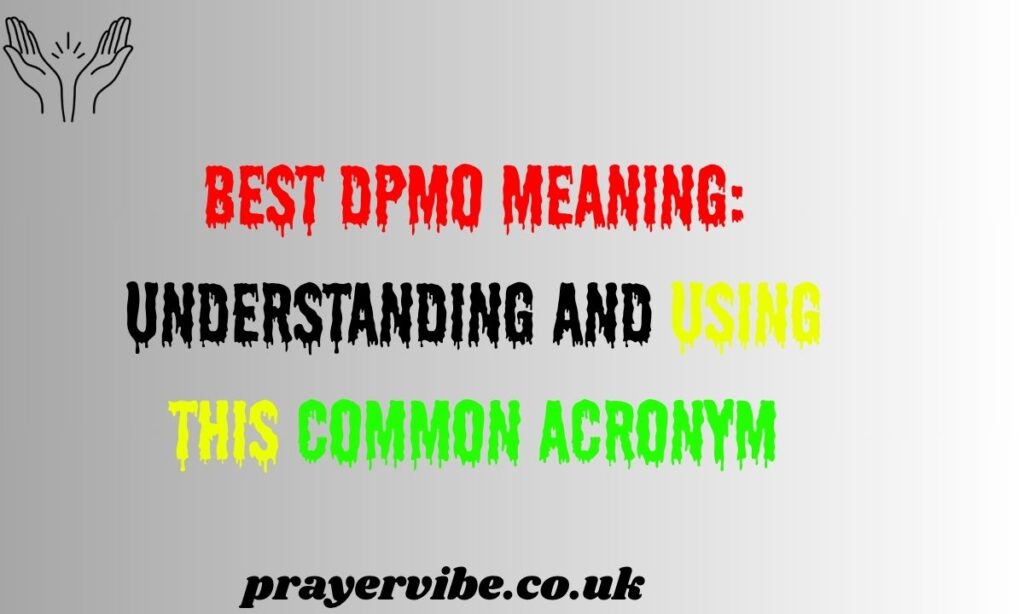In our interconnected digital age, acronyms and abbreviations dominate both professional and casual communication. DPMO is one such versatile acronym that serves different purposes depending on the context.
Whether you’re working in quality management or texting with friends, understanding DPMO’s multiple meanings can significantly improve your communication effectiveness.
This comprehensive guide will explore everything you need to know about DPMO, from its technical origins to its casual applications, helping you use it confidently in any situation.
What Does DPMO Mean?

DPMO has two primary meanings that vary dramatically based on context:
Professional Context: DPMO stands for “Defects Per Million Opportunities.” This is a critical quality metric used in Six Sigma methodology and lean manufacturing processes. It quantifies the number of defects occurring per one million opportunities in a given process, providing organizations with a standardized way to measure and improve quality performance.
Casual Context: In texting, social media, and informal digital communication, DPMO means “Don’t Piss Me Off.” This slang interpretation conveys frustration, annoyance, or serves as a playful warning between friends and acquaintances.
Understanding both interpretations is crucial for effective communication. Using the wrong meaning in the wrong context could lead to confusion, misunderstandings, or even professional embarrassment.
Origins of DPMO
Professional Origins: The business application of DPMO originated in the 1980s with Motorola’s development of Six Sigma methodology. This quality improvement approach aimed to reduce manufacturing defects to near-zero levels. DPMO became a cornerstone metric because it provides a consistent measurement standard across different processes, industries, and company sizes.
Six Sigma methodology gained widespread adoption in the 1990s when companies like General Electric implemented it company-wide, achieving billions in cost savings. Today, DPMO remains a fundamental tool for quality professionals worldwide.
Casual Origins: The slang version of DPMO emerged from internet culture and text messaging trends of the early 2000s. As mobile communication became more prevalent, users sought quick ways to express emotions and reactions. DPMO joined countless other acronyms that help convey tone and attitude in limited character formats.
Social media platforms and messaging apps accelerated the spread of this casual interpretation, making it common among younger demographics and digital natives.
When to Use DPMO in Professional Settings
In business environments, DPMO serves as a precise measurement tool with specific applications:
Quality Control Meetings: “Our manufacturing line achieved a DPMO of 150 last quarter, representing significant improvement from the previous 400 DPMO baseline.”
Performance Dashboards: Quality managers use DPMO to create visual representations of process performance, tracking trends over time and identifying improvement opportunities.
Vendor Management: “Supplier A maintains a DPMO of 75, while Supplier B averages 200 DPMO. This data influences our procurement decisions.”
Process Improvement Projects: Six Sigma Black Belts use DPMO to measure project success and demonstrate return on investment to stakeholders.
Customer Quality Reports: Many companies include DPMO metrics in customer-facing quality reports, demonstrating their commitment to excellence and continuous improvement.
Professional DPMO usage requires accuracy and context. Always provide supporting data and explain what constitutes a “defect” and an “opportunity” in your specific process.
Using DPMO Casually (Texting and Social Media)

In informal digital communication, DPMO expresses various levels of frustration or annoyance:
- Mild Frustration: “Traffic is crazy today, running late again. DPMO!”
- Playful Warning: “You better save me some pizza. DPMO if it’s all gone!”
- Setting Boundaries: “I told you I’m studying tonight. DPMO with the constant calls.”
- Expressing Annoyance: “Third time this week you’ve ‘forgotten’ to take out the trash. DPMO.”
The casual usage works best among friends, family, or peers who understand internet slang. Consider your audience carefully – using slang DPMO with professional contacts or older relatives might cause confusion.
Alternatives to DPMO (Professional Context)
Several alternatives can replace DPMO in business communication while maintaining clarity:
- Defect Rate: A more accessible term that expresses the same concept without technical jargon. Example: “Our defect rate decreased by 30% this quarter.”
- Quality Score: A positive framing that emphasizes achievement rather than problems. Example: “We achieved a 99.9% quality score on this product line.”
- Error Frequency: Highlights how often problems occur, useful for service industries. Example: “Customer service error frequency dropped to less than 1 per 1,000 interactions.”
- Process Capability: Focuses on what the process can achieve rather than what goes wrong. Example: “Our process capability meets Six Sigma standards.”
- First-Pass Yield: Emphasizes getting things right the first time. Example: “First-pass yield increased to 98.5%.”
Choose alternatives based on your audience’s technical knowledge and the story you want to tell with your data.
Alternatives to DPMO (Casual Context)
When texting or chatting online, several alternatives can replace casual DPMO:
Direct Alternatives:
- “Don’t test me” – More assertive and clear
- “Back off” – Direct but potentially harsher
- “Chill out” – Softer, more friendly approach
Playful Options:
- “Cut it out” – Light-hearted but firm
- “Knock it off” – Casual and familiar
- “Stop it” – Simple and straightforward
Expressive Alternatives:
- “You’re pushing it” – Implies approaching a limit
- “Don’t start” – Prevents escalation
- “Seriously?” – Questions the other person’s behavior
The key is matching your alternative to the relationship and situation. Close friends might appreciate more direct language, while acquaintances benefit from softer approaches.
How to Choose the Best Alternative?

Selecting the right alternative depends on several factors:
Professional Context Considerations:
- Audience technical knowledge level
- Industry standards and terminology
- Formality requirements
- Cultural considerations in global organizations
- Regulatory or compliance requirements
Casual Context Considerations:
- Relationship closeness with the recipient
- Age and generational differences
- Cultural background and communication styles
- Platform or medium being used
- Desired tone and outcome
General Guidelines:
- When in doubt, choose clearer, more widely understood terms
- Consider your long-term relationship with the recipient
- Match the communication style of your environment
- Be prepared to explain technical terms when necessary
- Stay authentic to your personal communication style
Texting Examples of DPMO and Alternatives
Scenario 1 – Running Late:
- DPMO Version: “Traffic is insane. Running 20 minutes late. DPMO!”
- Alternative: “Traffic is insane. Running 20 minutes late. Don’t be mad!”
Scenario 2 – Borrowed Items:
- DPMO Version: “Where’s my charger? You took it again. DPMO.”
- Alternative: “Where’s my charger? You took it again. Seriously?”
Scenario 3 – Repeated Reminders:
- DPMO Version: “Third text about the same thing. DPMO with the spam.”
- Alternative: “Third text about the same thing. Chill out with the spam.”
Scenario 4 – Setting Boundaries:
- DPMO Version: “I said I’m busy tonight. DPMO with the guilt trip.”
- Alternative: “I said I’m busy tonight. Cut it out with the guilt trip.”
Scenario 5 – Playful Warning:
- DPMO Version: “You better not eat my leftovers. DPMO!”
- Alternative: “You better not eat my leftovers. Don’t test me!”
Scenario 6 – Work Stress:
- DPMO Version: “Boss wants another revision. DPMO with these changes.”
- Alternative: “Boss wants another revision. I’m so done with these changes.”
Each example demonstrates how context and relationship dynamics influence the most appropriate choice.
Conclusion
DPMO’s dual nature as both a technical business term and casual slang expression makes it a fascinating example of how language evolves in our digital age. Whether you’re tracking quality metrics in a manufacturing environment or expressing frustration in a text message, understanding both interpretations ensures effective communication.
The key to using DPMO successfully lies in context awareness. Professional settings demand precision and clarity, while casual conversations allow for more expressive and emotional language. By recognizing these differences and choosing appropriate alternatives when needed, you can avoid misunderstandings and communicate more effectively.

Daniel Miller is a passionate writer, SEO expert, and blogger, specializing in Bible verses, prayers, and faith-based content at PrayerVibe.







